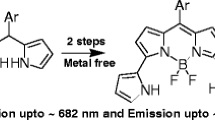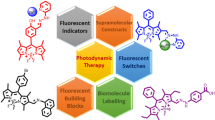Abstract
A series of six Bodipy derivatives, namely 4,4-difluoro-8-(4-amidophenyl)-1,3,5,7-tetramethyl-4-bora-3a,4a-diaza-s-indacene (1), 4,4-difluoro-8-(4-methylphenyl)-1,3,5,7-tetramethyl-4-bora-3a,4a-diaza-s-indacene (2), 4,4-difluoro-8-(4-nitrylphenyl)-1,3,5,7-tetramethyl-4-bora-3a,4a-diaza-s-indacene (3), 4,4-difluoro-8-(4-amidophenyl)-3,5-dimethyl-4-bora-3a,4a-diaza-s-indacene (4), 4,4-difluoro-8-(4-methylphenyl)-3,5-dimethyl-4-bora-3a,4a-diaza-s-indacene (5), and 4,4-difluoro-8-(4-nitrylphenyl)-3,5-dimethyl-4-bora-3a,4a-diaza-s-indacene (6) were structurally characterized by single crystal X-ray diffraction analysis. Two methyl substituents attached at C-1 and C-7 positions of boron-dipyrromethene (Bodipy) moiety in compounds 1–3 were revealed to prevent the free rotation of the benzene moiety, resulting in a molecular configuration with an almost orthogonal dihedral angle between the Bodipy and benzene moieties with the dihedral angle in the range of 81.14–88.56°. This is obviously different from that for 4–6 with a free-rotating benzene moiety relative to the Bodipy core due to the lack of two methyl substituents in the latter series of compounds, leading to an enhanced interaction between the Bodipy and benzene moieties for 4–6 in comparison with 1–3. The resulting larger HOMO–LUMO gap for 1–3 than 4–6 results in a blue-shifted absorption band for 1–3 relative to that for 4–6. Comparative studies over their fluorescence properties also disclose the blue-shifted fluorescence emission band and corresponding higher fluorescence quantum yield for 1–3 relative to those of 4–6, revealing the effect of molecular configuration on the spectroscopic properties of Bodipy derivatives. Comparison of the redox behaviors of these two series of Bodipy compounds provides additional support for this point. In addition, the electron-donating/withdrawing property of the para substituent of the benzene moiety was shown to exhibit a slight influence on the electronic absorption and fluorescence emission properties of the Bodipy compounds.
Similar content being viewed by others
References
A. Treibs and F. H. Kreuzer, Difluorboryl-komplexe von di- and tripyrrylmethenen, Justus Liebigs Ann. Chem., 1968, 718, 208–223.
J. Karolin, L. B. A. Johansson, L. Strandberg and T. Ny, Fluorescence and absorption spectroscopic properties of dipyrrometheneboron difluoride (BODIPY) derivatives in liquids, lipid membranes, and proteins, J. Am. Chem. Soc., 1994, 116, 7801–7803
E. J. Merino and K. M. Weeks, Facile conversion of aptamers into sensors using a 2′-ribose-linked fluorophore, J. Am. Chem. Soc., 2005, 127, 12766–12767
B. R. Sculimbrene and B. Imperiali, Lanthanide-binding tags as luminescent probes for studying protein interactions, J. Am. Chem. Soc., 2006, 128, 7346–7352.
J. L. Bricks, A. Kovalchuk, C. Trieflinger, M. Nofz, M. Buschel, A. I. Tolmachev, J. Daub and K. Rurack, On the development of sensor molecules that display FeIII -amplified fluorescence, J. Am. Chem. Soc., 2005, 127, 13522–13529
D. W. Domaille, L. Zeng and C. J. Chang, Visualizing ascorbate-triggered release of labile copper within living cells using a ratiometric fluorescent sensor, J. Am. Chem. Soc., 2010, 132, 1194–1195
K. Rurack, M. Kollmannsberger and J. Daub, Molecular switching in the near infrared (NIR) with a functionalized boron-dipyrromethene dye, Angew. Chem., Int. Ed., 2001, 40, 385–387.
K. Rurack, M. Kollmannsberger, U. Resch-Genger and J. Daub, A selective and sensitive fluoroionophore for HgII, AgI, and CuII with virtually decoupled fluorophore and receptor units, J. Am. Chem. Soc., 2000, 122, 968–969
Y. Gabe, Y. Urano, K. Kikuchi, H. Kojima and T. Nagano, Highly sensitive fluorescence probes for nitric oxide based on boron dipyrromethene chromophore-rational design of potentially useful bioimaging fluorescence probe, J. Am. Chem. Soc., 2004, 126, 3357–3367
K. Yamada, Y. Nomura, D. Citterio, N. Iwasawa and K. Suzuki, Highly sodium-selective fluoroionophore based on conformational restriction of oligoethyleneglycol-bridged biaryl Boron-dipyrromethene, J. Am. Chem. Soc., 2005, 127, 6956–6957
M. Baruah, W. Qin, R. A. L. Vallee, D. Beljonne, T. Rohand, W. Dehaen and N. Boens, A highly potassium-selective ratiometric fluorescent indicator based on BODIPY azacrown ether excitable with visible light, Org. Lett., 2005, 7, 4377–4379.
T. L. Arbeloa, F. L. Arbeloa, I. L. Arbeloa, I. Garcia-Moreno, A. Costela, R. Sastre and F. Amat-Guerri, Correlations between photophysics and lasing properties of dipyrromethene-BF2 dyes in solution, Chem. Phys. Lett., 1999, 299, 315–321.
G. Ulrich, R. Ziessel and A. Harriman, The chemistry of fluorescent bodipy dyes: versatility unsurpassed, Angew. Chem., Int. Ed., 2008, 47, 1184–1201
J. Q. Feng, B. L. Liang, D. L. Wang, L. Xue and X. Y. Li, Novel fluorescent dyes with fused perylene tetracarboxlic diimide and BODIPY analogue structures, Org. Lett., 2008, 10, 4437–4440
J. Wang and X. Qian, Two regioisomeric and exclusively selective Hg(II) sensor molecules composed of a naphthalimide fluorophore and an o-phenylenediamine derived triamide receptor, Chem. Commun., 2006, 109–111.
A. Loudet and K. Burgess, BODIPY dyes and their derivatives: syntheses and spectroscopic properties, Chem. Rev., 2007, 107, 4891–4932
K. Tanaka, T. Miura, N. Umezawa, Y. Urano, K. Kikuchi, T. Higuchi and T. Nagano, Rational design of fluorescein-based fluorescence probes: Mechanism-based design of a maximum fluorescence probe for singlet oxygen, J. Am. Chem. Soc., 2001, 123, 2530–2536.
S. Ozlem and E. U. Akkaya, Thinking outside the silicon box: Molecular AND logic as an additional layer of selectivity in singlet oxygen generation for photodynamic therapy, J. Am. Chem. Soc., 2009, 131, 48–49.
Z. Shen, H. Rohr, K. Rurack, H. Uno, M. Spieles, B. Schulz, G. Reck and N. Ono, Boron-diindomethene (BDI) dyes and their tetrahydrobicyclo precursors-en route to a new class of highly emissive fluorophores for the red spectral range, Chem.–Eur. J., 2004, 10, 4853–4871.
T. Yogo, Y. Urano, Y. Ishitsuka, F. Maniwa and T. Nagano, Highly efficient and photostable photosensitizer based on BODIPY chromophore, J. Am. Chem. Soc., 2005, 127, 12162–12163.
K. Yamada, T. Toyota, K. Takakura, M. Ishimaru and T. Sugawara, Preparation of BODIPY probes for multicolor fluorescence imaging studies of membrane dynamics, New J. Chem., 2001, 25, 667–669.
H. Sunahara, Y. Urano, H. Kojima and T. Nagano, Design and synthesis of a library of BODIPY-based environmental polarity sensors utilizing photoinduced electron-transfer-controlled fluorescence ON/OFF switching, J. Am. Chem. Soc., 2007, 129, 5597–5604.
C. Goze, G. Ulrich, L. J. Mallon, B. D. Allen, A. Harriman and R. Ziessel, Synthesis and photophysical properties of borondipyrromethene dyes bearing aryl substituents at the boron center, J. Am. Chem. Soc., 2006, 128, 10231–10239.
C. Goze, G. Ulrich and R. Ziessel, Tetrahedral boron chemistry for the preparation of highly efficient “cascatelle” devices, J. Org. Chem., 2007, 72, 313–322.
C. Goze, G. Ulrich and R. Ziessel, Unusual fluorescent monomeric and dimeric dialkynyl dipyrromethene-borane complexes, Org. Lett., 2006, 8, 4445–4448.
A. Cui, X. Peng, J. Fan, X. Chen, Y. Wu and B. Guo, Synthesis, spectral properties and photostability of novel boron-dipyrromethene dyes, J. Photochem. Photobiol., A, 2007, 186, 85–92.
J. Shin, B. O. Patrick and D. Dolphin, Self-assembly via intermolecular hydrogen-bonding between o-/m-/p-NH2 and BF2 groups on dipyrromethenes, Tetrahedron Lett., 2008, 49, 5515–5518.
M. Broring, R. Kruger, S. Link, C. Kleeberg, S. Kohler, X. Xie, B. Ventura and L. Flamigni, Bis(BF2)-2,2′-bidipyrrins (BisBODIPYs): highly fluorescent BODIPY dimers with large stokes shifts, Chem.–Eur. J., 2008, 14, 2976–2983.
Y. Zhao and D. G. Truhlar, Benchmark databases for nonbonded interactions and their use to test density functional theory, J. Chem. Theory Comput., 2005, 1, 415–432
Y. Zhao and D. G. Truhlar, Design of density functionals that are broadly accurate for thermochemistry, thermochemical kinetics, and nonbonded interactions, J. Phys. Chem. A, 2005, 109, 5656–5657.
M. J. Frisch, G. W. Trucks, H. B. Schlegel, G. E. Scuseria, M. A. Robb, J. R. Cheeseman, J. A. Montgomery, Jr., T. Vreven, K. N. Kudin, J. C. Burant, J. M. Millam, S. S. Iyengar, J. Tomasi, V. Barone, B. Mennucci, M. Cossi, G. Scalmani, N. Rega, G. A. Petersson, H. Nakatsuji, M. Hada, M. Ehara, K. Toyota, R. Fukuda, J. Hasegawa, M. Ishida, T. Nakajima, Y. Honda, O. Kitao, H. Nakai, M. Klene, X. Li, J. E. Knox, H. P. Hratchian, J. B. Cross, V. Bakken, C. Adamo, J. Jaramillo, R. Gomperts, R. E. Stratmann, O. Yazyev, A. J. Austin, R. Cammi, C. Pomelli, J. Ochterski, P. Y. Ayala, K. Morokuma, G. A. Voth, P. Salvador, J. J. Dannenberg, V. G. Zakrzewski, S. Dapprich, A. D. Daniels, M. C. Strain, O. Farkas, D. K. Malick, A. D. Rabuck, K. Raghavachari, J. B. Foresman, J. V. Ortiz, Q. Cui, A. G. Baboul, S. Clifford, J. Cioslowski, B. B. Stefanov, G. Liu, A. Liashenko, P. Piskorz, I. Komaromi, R. L. Martin, D. J. Fox, T. Keith, M. A. Al-Laham, C. Y. Peng, A. Nanayakkara, M. Challacombe, P. M. W. Gill, B. G. Johnson, W. Chen, M. W. Wong, C. Gonzalez and J. A. Pople, GAUSSIAN 03 (Revision B.05), Gaussian, Inc., Wallingford, CT, 2004.
Y. Urano, M. Kamiya, T. Kanda, T. Ueno, K. Hirose and T. Nagano, Evolution of fluorescein as a platform for finely tunable fluorescence probes, J. Am. Chem. Soc., 2005, 127, 4888–4894.
H. L. Kee, C. Kirmaier, L. Yu, P. Thamyongkit, W. J. Youngblood, M. E. Calder, L. Ramos, B. C. Noll, D. F. Bocian, W. R. Scheidt, R. R. Birge, J. S. Lindsey and D. Holten, Structural control of the photodynamics of boron-dipyrrin complexes, J. Phys. Chem. B, 2005, 109, 20433–20443.
J. Banuelos Prieto, F. Lopez Arbeloa, V. Martınez Martınez, T. Arbeloa Lopez, F. Amat-Guerri, M. Liras and I. Lopez Arbeloa, Photophysical properties of a new 8-phenyl analogue of the laser dye PM567 in different solvents: internal conversion mechanisms, Chem. Phys. Lett., 2004, 385, 29–35.
Y. H. Yu, A. B. Descalzo, Z. Shen, H. Rohr, Q. Liu, Y. W. Wang, M. Spieles, Y. Z. Li, R. K. Urack and X. Z. You, Mono- and di(dimethylamino)styryl-substituted borondipyrromethene and borondiindomethene dyes with intense near-infrared fluorescence, Chem.–Asian J., 2006, 1, 176–187.
J. Waluk, Ground- and excited-state tautomerism in porphycenes, Acc. Chem. Res., 2006, 39, 945–952.
W. Qin, M. Baruah, M. Van der Auweraer, F. C. De Schryver and N. Boens, Photophysical properties of borondipyrromethene analogues in solution, J. Phys. Chem. A, 2005, 109, 7371–7384.
T. Ueno, Y. Urano, H. Kojima and T. Nagano, Mechanism-based molecular design of highly selective fluorescence probes for nitrative stress, J. Am. Chem. Soc., 2006, 128, 10640–10641.
Author information
Authors and Affiliations
Corresponding author
Additional information
Electronic supplementary information (ESI) available: Molecule orbital energy levels for 1–6; electronic absorption and fluorescent spectra properties of compounds 1–6 in different solvents. CCDC reference numbers 798782–798787. For ESI and crystallographic data in CIF or other electronic format see DOI: 10.1039/c1pp00001b
Rights and permissions
About this article
Cite this article
Chen, Y., Wan, L., Zhang, D. et al. Modulation of the spectroscopic property of Bodipy derivates through tuning the molecular configuration. Photochem Photobiol Sci 10, 1030–1038 (2011). https://doi.org/10.1039/c1pp00001b
Received:
Accepted:
Published:
Issue Date:
DOI: https://doi.org/10.1039/c1pp00001b




